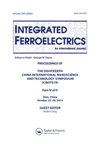Phase Formation, Microstructure and Electric Properties of Vanadium Doped Lead-Free BaTi 0.91 Sn 0.09 O 3 Ceramics
IF 0.7
4区 工程技术
Q4 ENGINEERING, ELECTRICAL & ELECTRONIC
引用次数: 0
Abstract
Abstract Lead-free Ba(Ti0.91Sn0.09)1-xVxO3 (BTSV, x = 0, 0.005,0.010, 0.015, and 0.020) ceramics were prepared by the conventional solid-state sintering method with a calcination temperature of 1200 °C for 2 h and a sintering temperature between 1350 °C and 1400 °C for 4 h. The effect of vanadium (V) doping on the phase formation, microstructure and electrical properties of the ceramics was investigated. X-ray diffraction (XRD) measurements revealed that the ceramics with x = 0 and 0.005 had pure perovskite structures with no detectable impurity, while the ceramics with x ≥ 0.010 exhibited perovskite structures and had secondary impurity phases. Coexisting orthorhombic and tetragonal phases were observed and the Rietveld refinement analysis suggested that the tetragonal phase increased with increased V5+ substitution. When x increased from 0 to 0.010, the average grain size increased from 47 to 62 µm and then dropped, while the density (ρ) decreased from 5.98 to 5.64 g/cm3 when x increased. Furthermore, the BTSV ceramics exhibited increased porosity, Curie temperatures (T C ∼ 42 °C to 52 °C) and coercive field (E c), while the dielectric constant at the Curie temperature (εC) and the remnant polarization (P r) of the ceramics decreased (∼18023 to 6110 and ∼7.42 to 4.88 µC/cm2, respectively) when V5+ doping increased.钒掺杂无铅BaTi 0.91 Sn 0.09 o3陶瓷的相形成、微观结构和电性能
摘要采用传统的固相烧结法,在1200℃煅烧2 h, 1350 ~ 1400℃烧结4 h的条件下,制备了无铅Ba(Ti0.91Sn0.09)1-xVxO3 (BTSV, x = 0、0.005、0.010、0.015和0.020)陶瓷,研究了钒(V)掺杂对陶瓷相形成、微观结构和电学性能的影响。x射线衍射(XRD)测试表明,x = 0和0.005的陶瓷具有纯钙钛矿结构,没有检测到杂质,而x≥0.010的陶瓷具有钙钛矿结构,具有次生杂质相。观察到正交相和四方相共存,Rietveld细化分析表明,四方相随着V5+取代的增加而增加。当x从0增加到0.010时,平均晶粒尺寸从47 μ m增加到62 μ m,然后下降,而密度(ρ)随着x的增加从5.98减小到5.64 g/cm3。此外,随着V5+掺杂的增加,BTSV陶瓷的孔隙率、居里温度(TC ~ 42°C ~ 52°C)和矫顽力场(Ec)均有所增加,而居里温度下的介电常数(εC)和残余极化(Pr)分别降低了(~ 18023 ~ 6110µC/cm2和~ 7.42 ~ 4.88µC/cm2)。关键词:相形成;微观结构;电场细化;介电;同时感谢Kyle V. Lopin博士助理教授对本文的编辑工作。披露声明作者未报告潜在的利益冲突。本研究由国家科学研究与创新基金(NSRF)通过南京大学资助[R2566B038]。N. Vittayakorn的工作是由KMITL资助的。[KREF116501]。
本文章由计算机程序翻译,如有差异,请以英文原文为准。
求助全文
约1分钟内获得全文
求助全文
来源期刊

Integrated Ferroelectrics
工程技术-工程:电子与电气
CiteScore
1.40
自引率
0.00%
发文量
179
审稿时长
3 months
期刊介绍:
Integrated Ferroelectrics provides an international, interdisciplinary forum for electronic engineers and physicists as well as process and systems engineers, ceramicists, and chemists who are involved in research, design, development, manufacturing and utilization of integrated ferroelectric devices. Such devices unite ferroelectric films and semiconductor integrated circuit chips. The result is a new family of electronic devices, which combine the unique nonvolatile memory, pyroelectric, piezoelectric, photorefractive, radiation-hard, acoustic and/or dielectric properties of ferroelectric materials with the dynamic memory, logic and/or amplification properties and miniaturization and low-cost advantages of semiconductor i.c. technology.
 求助内容:
求助内容: 应助结果提醒方式:
应助结果提醒方式:


